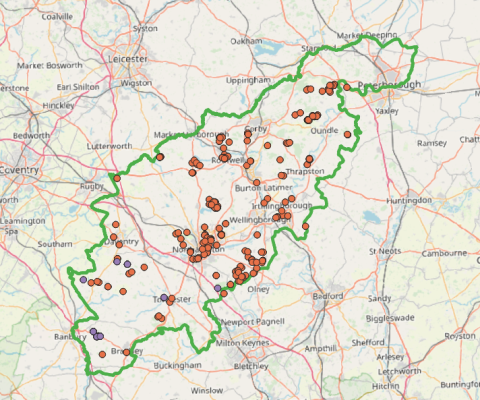
It will soon be time to look out for and report beeflies in Northants. They usually emerge in mid-late March but it is possible that some could be found in late February in mild, sheltered spots. Until 2018, we only had one species in Northants. This was the widespread Dark-edged Beefly, Bombylius major. However in 2018 a second species, the Dotted Beefly, Bombylius discolor, was photographed in Boddington churchyard. Several more have been seen since but so far they have been mainly confined to the South-west of the county. The Dotted Beefly has been expanding its range northwards from the Chilterns and I hope that this will continue. Here is a map of records up to the end of 2021. The orange dots represent Dark-edged Beefly and the purple dots Dotted Beefly.
The two flies are easily identified when perched but virtually impossible to separate when flying as their wings beat so quickly. As the Dotted Beefly is still quite scarce we do ask that people photograph or confirm that they have clearly seen the wings when recording this species. Both species look a little like brown bumblebees but they have a very long proboscis, which they use to drink nectar from flowers like primroses and their antennae are short, not like the long antennae of bumblebees. The Dark-edged Beefly has dark markings along the front edge of the wing whereas the Dotted Beefly’s wings have a series of spots on them and not a strong dark front edge. The photos below show the two species. There are other species of beefly in the UK but none come close to Northants.

Beeflies can be found in sheltered, sunny locations where their prey, mining bee species can be found. Sheltered banks, wood edges and wildlife gardens are good places to look, especially if there are primroses growing there. Both species are pollinators of primroses and other spring species. In my garden they are also attracted to grape hyacinth (Muscari) and Veronica peduncularis.
Both flies are parasitoids of mining bee larvae, especially the Ashy Mining Bee Andrena cineraria. The female flies have a small pouch under their abdomen in which they collect dust from the ground. They then mix this with their sticky eggs and flick the eggs into suitable areas where the bees may be nesting. A small, mobile larva emerges from the egg and tries to work its way into a nest hole. If they can find a bee larva they will lie next to it and wait until the bee larva is nearly fully grown. The fly larva then attaches itself to the bee larva and consumes its internal juices. When nearly ready to pupate the fly larva moves away from its host. The pupa can remain in the ground for up to two years before it wriggles to the surface and the adult fly hatches.
If you do find any beeflies please note the species, date, location, (ideally with 6 figure grid ref.) and your name and send the record to the Northants Biodiversity Records Centre, Look out for beeflies survey.
John Showers, Northants County Recorder for Diptera.

